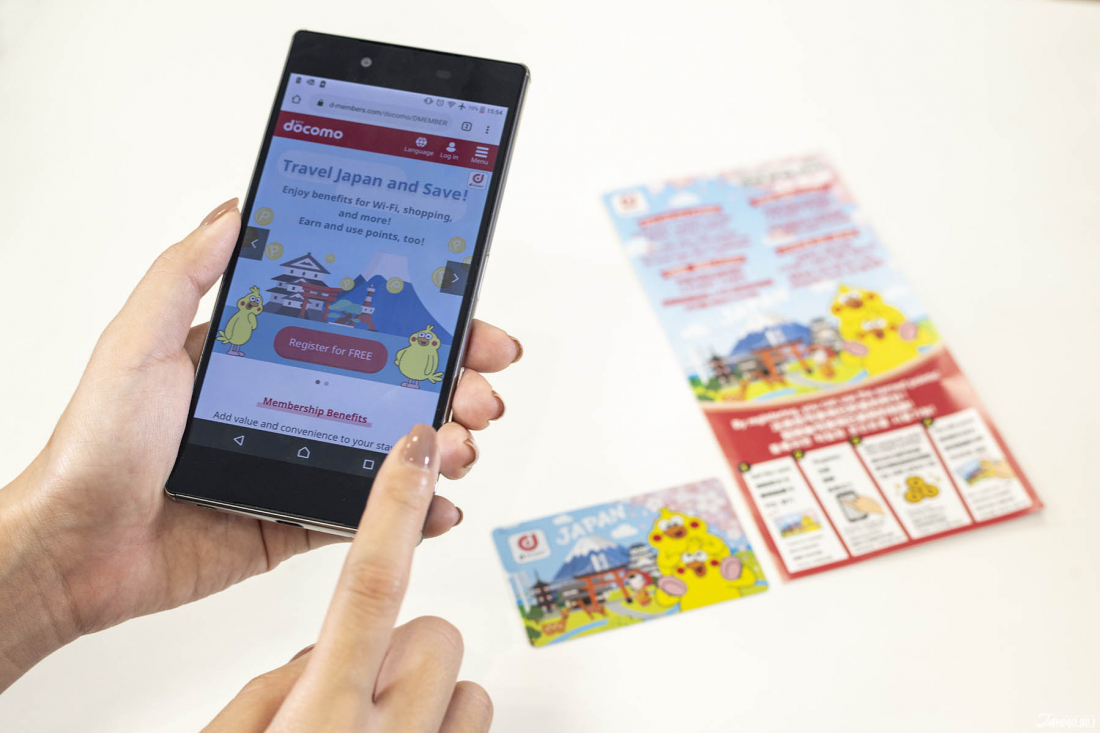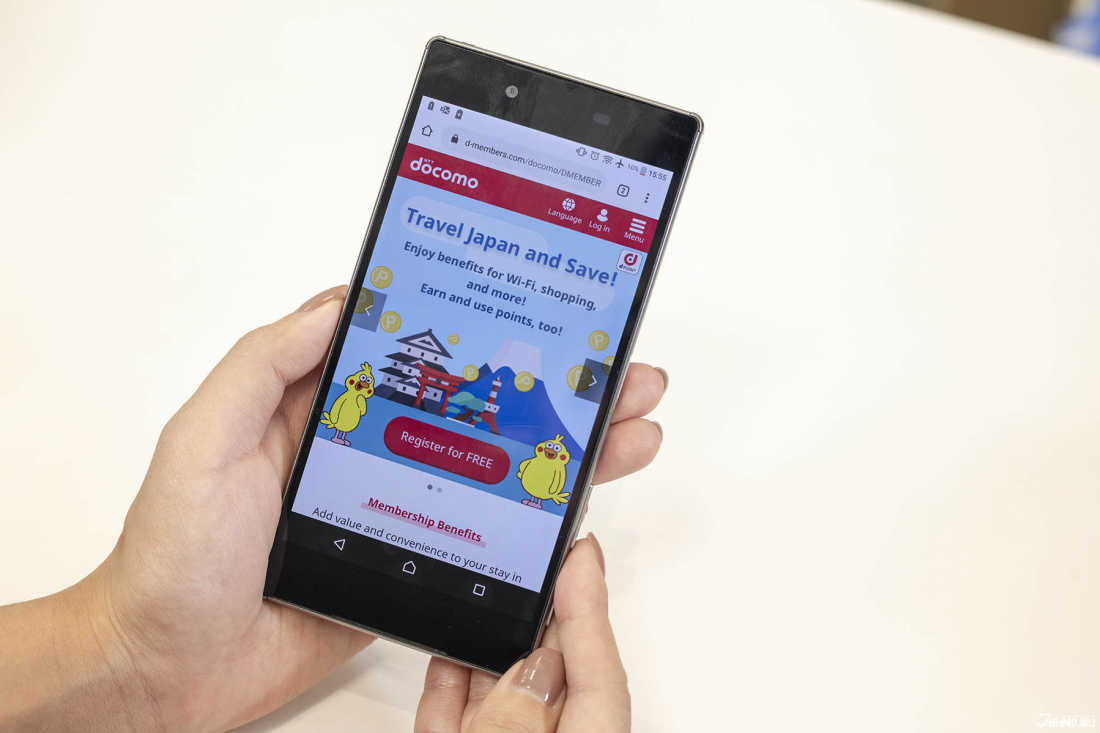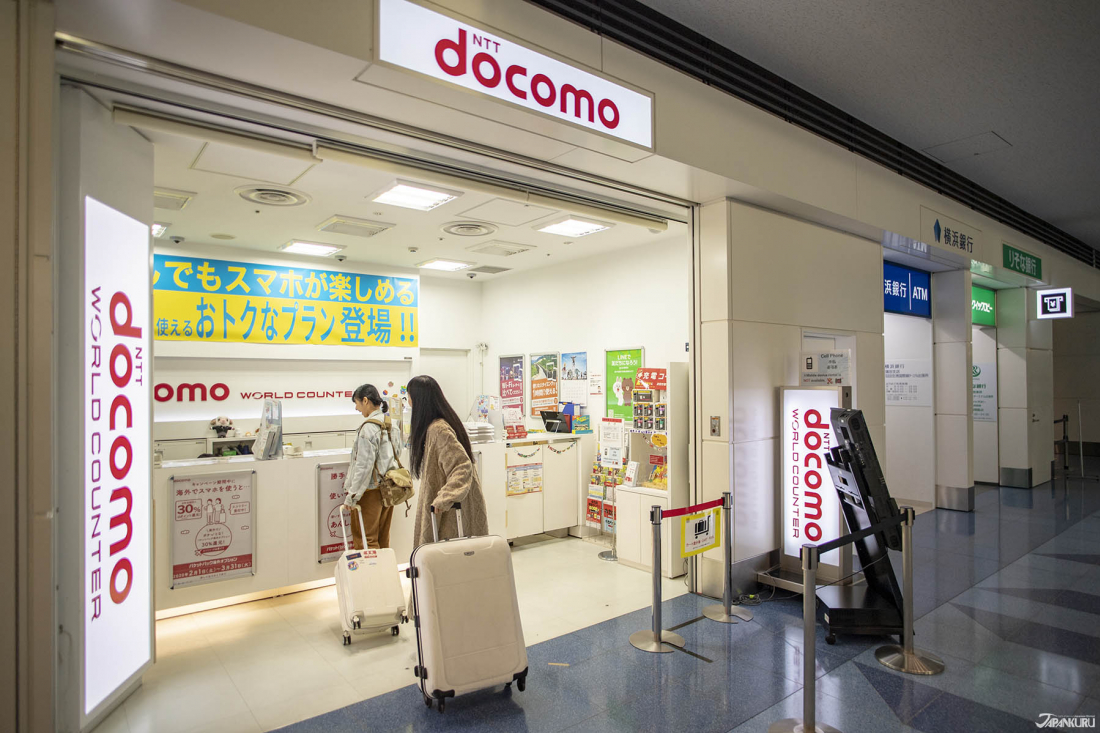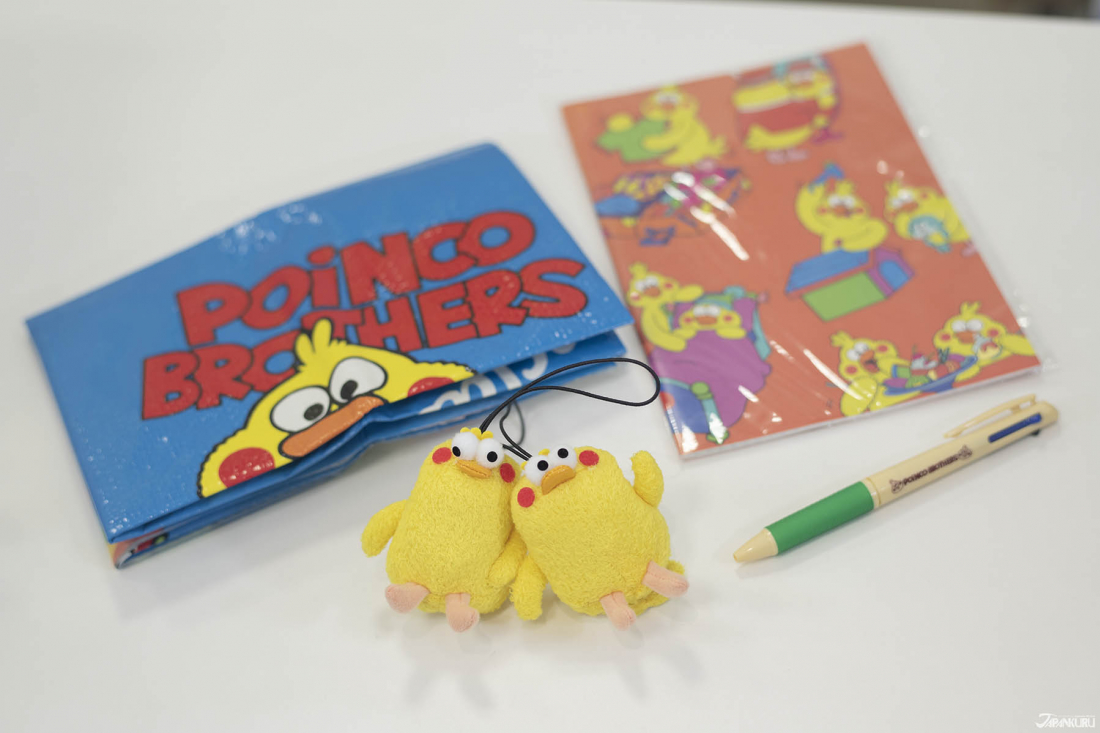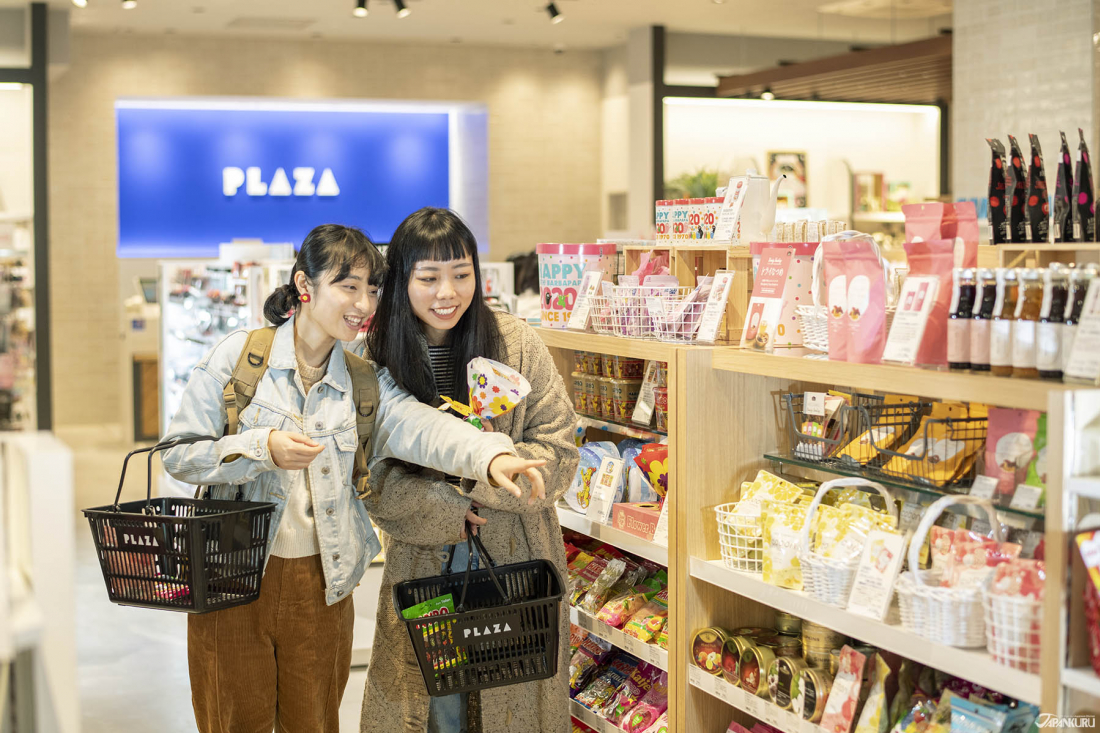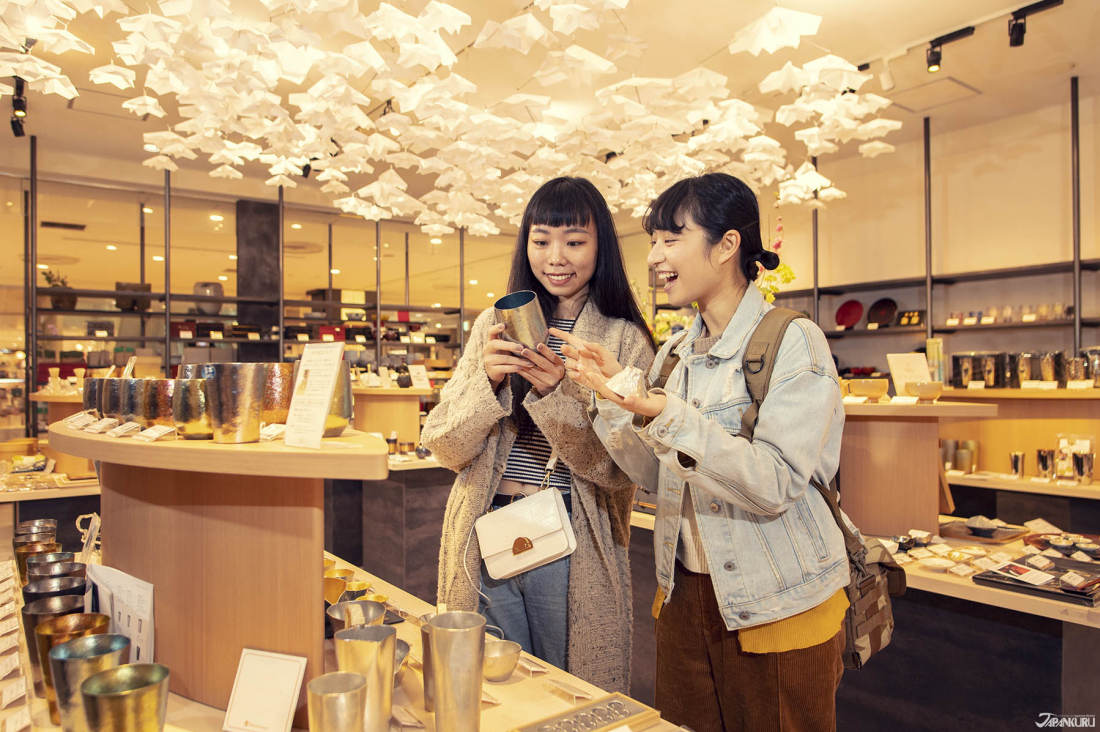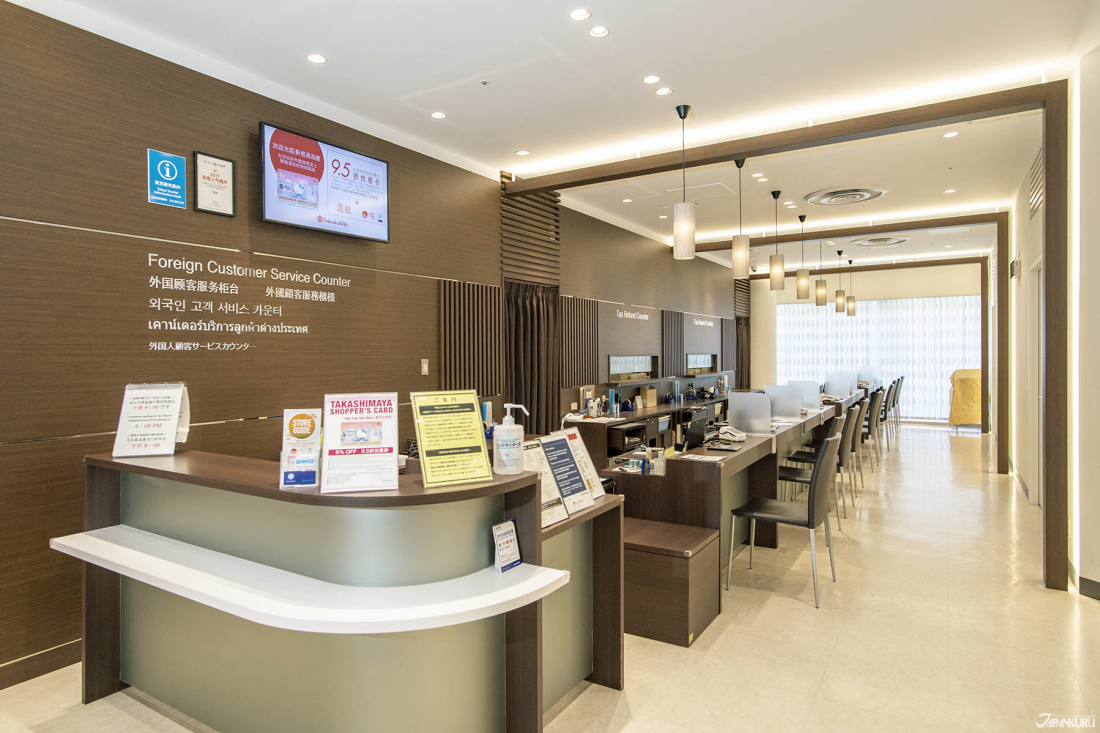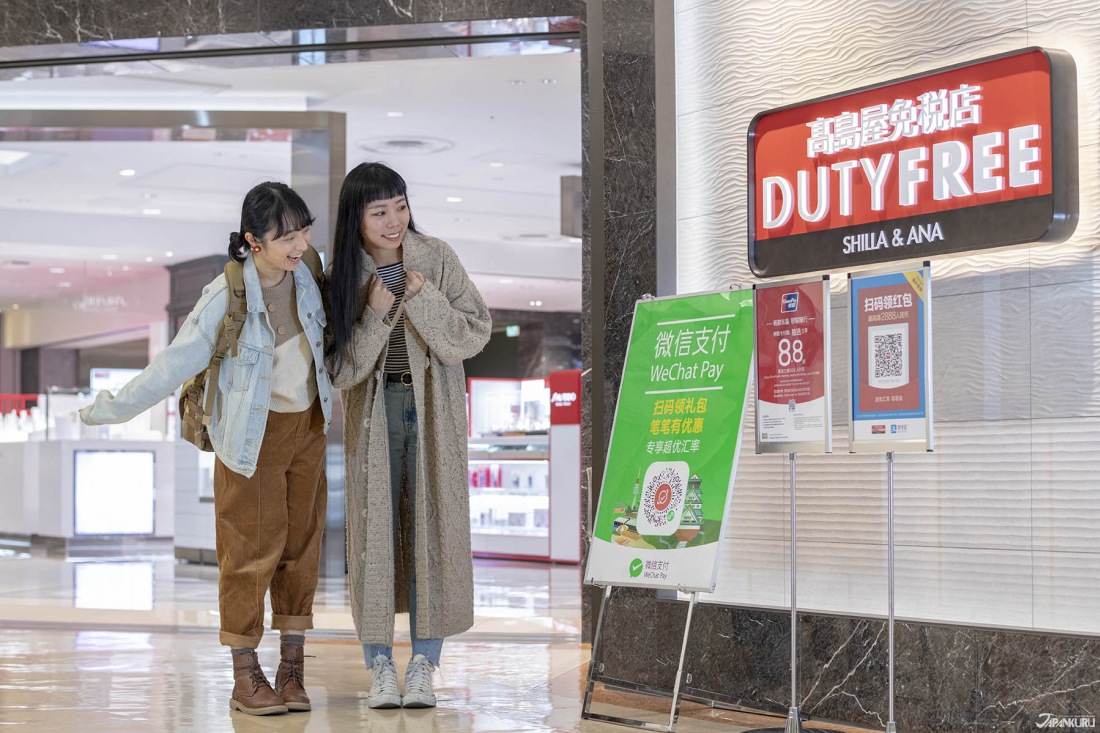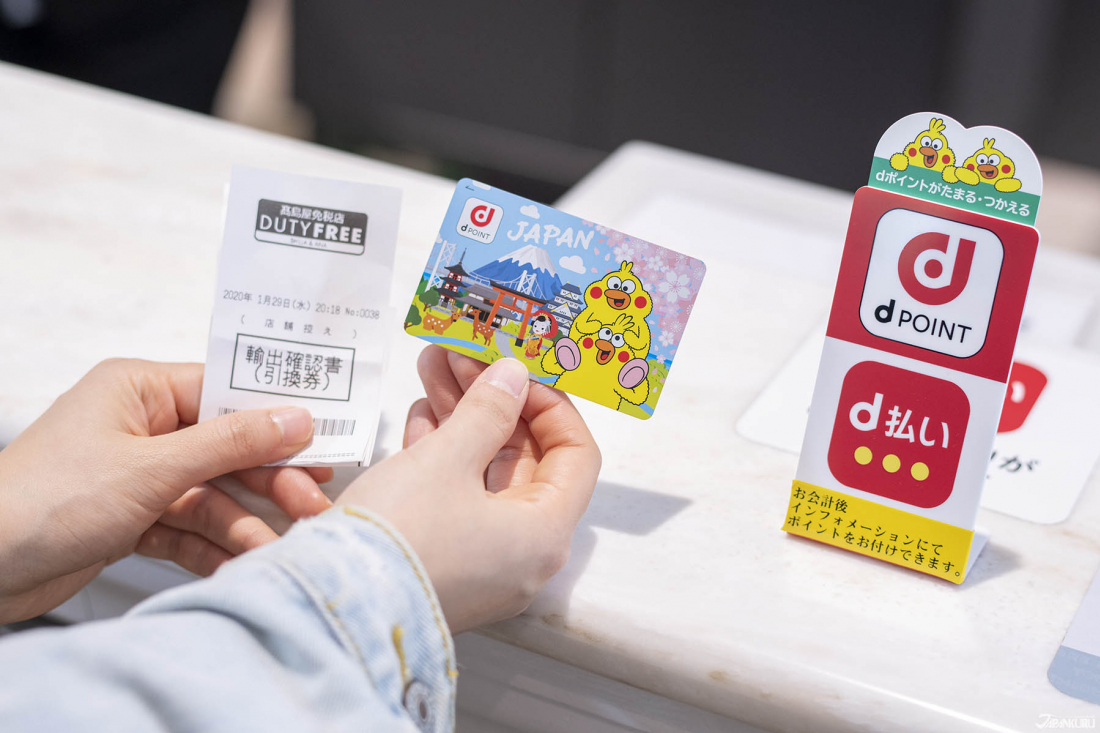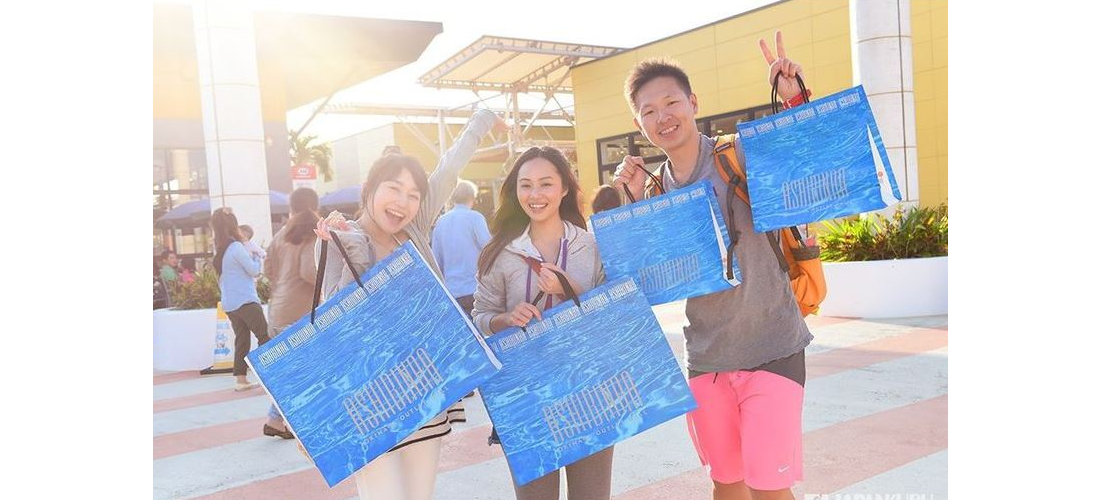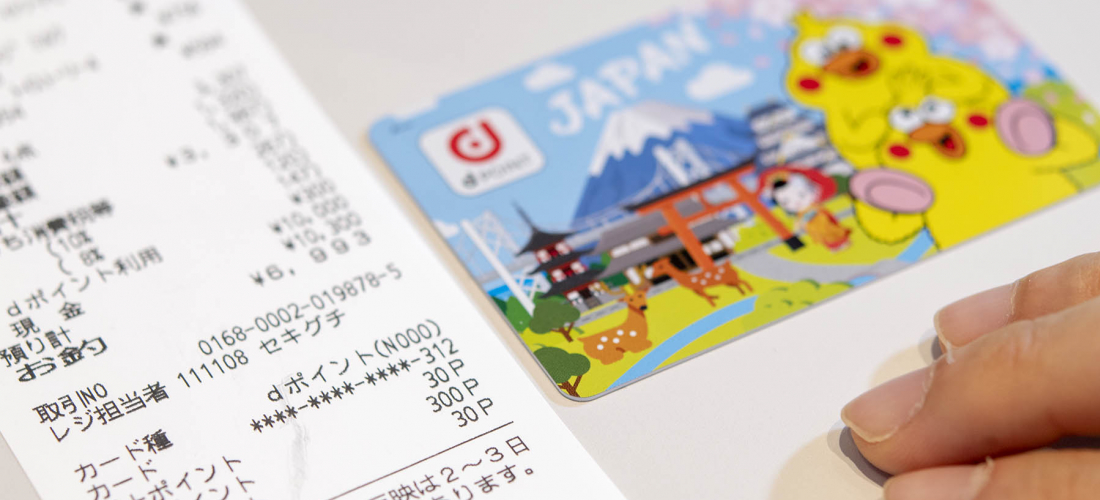
CONTENTS
Love earning points when you’re out shopping? Using your points to get discounts on your next purchases, searching out coupons for your favorite shops, and getting your hands on freebies in the process? Well, so does the JAPANKURU team! So we’re here to tell you how you can do that during your visit to Japan, too! One of Japan’s most popular point systems is the d POINT, which you can actually earn at hundreds of different shops and restaurants throughout Japan, and even around New York, Hawaii, and Guam. The d POINT system comes from DOCOMO, one of Japan’s three major communications giants, so you’ll see it just about everywhere. Let us tell you just why (and how) you’ll want to register now, and start racking up points as soon as you arrive in Japan.
Presented by NTT DOCOMO, INC.
What is the d POINT CLUB?
While many parts of the world rely on loyalty cards or local payment applications to collect points when shopping, in Japan the system works a little differently. Register a d POINT CARD (for free!), and all you have to do to start racking up points during your trip to Japan is scan it when you're checking out at any of hundreds of different Japanese stores. We recommend you register before arriving in Japan, so you can start earning from your first day. (There's nothing more frustrating than missing out on the points you know you could have earned.) The registration process is simple (just input some basic information), totally free, and it took us maybe two minutes to complete on our smartphones (you can register on a desktop computer as well). You could even register right at this link, right now, and you'd be done in almost the same time as it takes to scroll through the rest of this page.
Unlike frustrating single-store cards, you can earn d POINTs in a variety of shops – everything from convenience stores and fast food joints, to duty-free shops and outlet malls. Then, you can use the points in tons of different stores, too! Depending on the shop, you earn 1 point per 100-200 yen, and then can use 1 point as 1 yen. And the benefits just start there – being a d POINT member gives you access to special discounts, some fun novelties, and more. On top of all of that, this particular d POINT CARD and the corresponding multi-lingual website is made to cater to foreign visitors to Japan, which is why it's so easy for travelers to use! Check out our experiences with the d POINT CARD, and why we're fans.
*Please note that the information in this article is from the time of writing or publication and may differ from the latest information, and d POINT validity periods, rates, usability, and other policies may vary depending on the company, service, or product. Some businesses, products, and services are exempt.
How to Register, Get Your Card, and Get Started
If you love to save, and you love to travel, you probably know that the time to start planning for your trip to Japan is now! Or as early as possible. Of course, getting the timing right for the best prices on plane tickets and hotel reservations can be difficult. Fortunately, though, we were pleasantly surprised at how easy it was to get started with the d POINT CARD.
We're a pretty international team over here at JAPANKURU, so we were excited to find that the registration could be done in English, Korean, Traditional and Simplified Chinese (plus Thai, starting in April)! No need to search through a Japanese website, or make any phone calls – we just each used the website in our language of choice. Here's a simple rundown of how it works:
Before You Get to Japan:
① Go to the d POINT member site, on your phone or computer.
② Click the Register for FREE button.
③ Enter your e-mail address, name, and other basic information, then complete the registration.
And you're done! At this point, you can start looking at the coupons and other benefits, and check which stores in Japan participate in the d POINT system, to start planning some shopping lists.
Now, let's just get ourselves to Japan…
We've arrived! Once you get to Japan, it's time to get ahold of the card itself, and start using it!
After Arriving in Japan:
① Pick up your card! Their official website has a list of pickup locations, many in Japanese airports.
② Register your new card on the official website. Simply follow the directions in the pamphlet, and scan the Registration Page QR code to get started.
③ Get your 300 free d POINTs (equivalent to 300 yen) by scanning the QR code printed behind the d POINT CARD inside the pamphlet.
④ Start enjoying your time in Japan as you earn and use your d POINTs!
For our cards, we stopped by the DOCOMO World Counter in Tokyo's Haneda Airport. (If you're arriving in one of Japan's other major international airports, there are pickup locations in most of them!) We were relieved that the process didn't involve any long phone calls in Japanese or confusing instructions. After your flight touches down, just head to the pickup counter, and you're set for the rest of the trip!
The d POINT Membership Benefits
(Here’s why we recommend it!)
We had a lot of fun seeing everything the d POINT CARD can do, on top of the simple process of collecting and using points. Not sure how much you'd really take advantage of the member benefits? Let us show you how we did it!
① Getting Our Hands on Some Cute Novelties
The first benefit came up before we even left the airport – a free gift of a POiNCO item! Stop by any d POINT benefit reception spot, and new d POINT members can choose one of a handful of novelty items featuring the d POINT mascots, the POiNCO BROTHERS. These guys are two bright yellow parrots, and their silly faces are just too cute.
It was hard deciding which of the original items we wanted to take with us! The practical pen? The soft, fluffy charms?? (The items are subject to change, but which will you choose!?)
*The “leisure sheet” (plastic picnic sheet) shown above is no longer available after March 31, 2020.
② Using the Premium Coupons
One of the d POINT member benefits we were most excited to put to use was the premium coupons, and we had a chance to use them pretty immediately! We happily noticed that one of the coupons available is for JAL ABC, a baggage delivery service. That means that before we left the airport and headed out into Tokyo, we were able to just send our suitcases to our hotels, and not worry about dragging them everywhere we wanted to go that day! The premium coupon got us 15% off the standard JAL ABC fee, making it especially affordable. Nice!
As we were looking at all the other premium coupons available, we saw some friendly faces peering back at us, the POiNCO BROTHERS! It turns out, one of the coupons gets you 10% off your total at POiNCO Markets inside of DOCOMO shops around Japan, where they sell even more adorable POiNCO BROTHERS items! We were so charmed by the novelty gifts we got at the airport that we decided our first stop had to be a chance to find some more.
Using the premium coupons is actually really easy – just go to the coupon page on the member site, click on the coupon you want to use, and then check the directions.
③ Taking Advantage of the 1-Day Free Wi-Fi
While the JAPANKURU team definitely loves some good shopping, one of the d POINT CLUB member benefits we knew would be extremely practical during a trip to Japan was the free docomo wi-fi, available all over the country. This wi-fi relies on hot spots found absolutely everywhere around Japan, and the spots are packed so tight in Tokyo we noticed them constantly.
Until April 14th, d POINT CLUB members can use one day of free docomo wi-fi (already pretty useful!). From April 15th 2020*, however, “d Wi-Fi” will become a new member benefit, and after signing up (for free), d POINT CLUB members will actually be able to use the wide-ranging docomo wi-fi network for free… for their entire trip to Japan!
*Dates subject to change.
During our time out and about in Asakusa, after visiting Sensoji Temple, we realized we weren't sure how to get to our next destination. "If only we had wi-fi to look this up!" we exclaimed, and after a quick check, we realized that there was a DOCOMO hotspot right where we were standing in the middle of things! We quickly followed the directions on the d POINT member site for how to start using our free wi-fi, and were checking train directions in no time. So handy!
④ Putting Our d POINTs to Use
Finally, time to start shopping in earnest, and time to make the most of our new d POINT CARDs!
We decided our first stop would be Plaza, which is what they call a "zakka" (雑貨) shop in Japan – it means they sell fun variety goods of all kinds. A perfect place to earn, and use some d POINTs!
Plaza Tokyo Branch
A Building, Tokyo International Forum 1F, 3-5-1 Marunouchi, Chiyoda-ku, Tokyo
Weekday Hours: 11:00 – 21:00 / Weekend Hours: 10:00 – 20:00
Official Website (jp)
In the end, we ended up getting a whole bag of cookies, chocolate, and… socks! But more importantly, we used our 300 points as 300 yen, paying for a portion of our purchase total! It felt like we were getting free chocolate! Even though we'd used points to pay for part of our purchase, we actually still earned d POINTs at the same time. Since we did pay 3,000 yen with our own money, we got 30 new points. You can see the point totals conveniently displayed at the bottom of our receipt.
Spurred on by the fun of using our first 300 d POINTs, we wanted to earn more! It turns out that Takashimaya department stores in Shinjuku have an agreement with d POINT, and customers can earn d POINTs on all their Shinjuku Takashimaya purchases – an unusual agreement in Japan!
We were especially intrigued by the area set aside for traditional Japanese items on the 10th floor of the Shinjuku Takashimaya. It was all too easy to spend the afternoon looking through the splendidly sculpted traditional Japanese teapots, the more modern, elegantly-shaped sake cups, items decorated with Mt. Fuji motifs, and much more. So many good souvenir options! And so many d POINTS!
Because Shinjuku Takashimaya is a department store with lots of registers, they make it easy to get the d POINTs earned from all your Shinjuku Takashimaya purchases all at once. Just head up to their tax-free counter on the 11th floor, hand over all your Shinjuku Takashimaya receipts and your d POINT CARD, and you'll get d POINTs added to the card!
Shinjuku Takashimaya
5-24-2 Sendagaya, Shibuya-ku, Tokyo
Sun~Thur Hours: 10:00 – 20:00 / Fri~Sat Hours: 10:00 – 20:30
Official Website
We weren't quite ready to stop shopping yet, though! We noticed the little d POINT signs in A&S Takashimaya Duty Free, and had to take a look. If you want to earn d POINTs on some high-end cosmetics, and to get some pretty good deals while you're at it, this might be the place for you.
Success! Now we've got plenty more d POINTs to use on our next purchase!
A&S Takashimaya Duty Free
Takashimaya Times Square, 11th Floor
So What Are You Waiting For?
Between the 300 d POINTs we were able to use as 300 yen on whatever we wanted at participating stores, the cute characters and fun novelties, the premium coupons, and the totally convenient free wi-fi, we had zero regrets after signing up for d POINT! If even one of the member benefits seemed like it might come in handy, we can't see any reason not to go for it, so why wait? Since the registration only takes a minute or two, you can head to the d POINT website now, before you forget, and you'll be ready to go as soon as you arrive in Japan. We hope you have as much fun collecting lots of d POINTs as we did. Safe travels!
*Please note that the information in this article is from the time of writing or publication and may differ from the latest information.
Presented by NTT DOCOMO, INC.
PROFILE
Follow us @Japankuru on Facebook, Instagram, and Twitter!
COMMENT
FEATURED MEDIA
VIEW MORE
Which snacks make the best Japanese souvenirs?~ Jaga Pirika ~ 일본과자 선물 뭐하지?~자가피리카 편~ #pr #calbee #jagapokkuru #japanesesnacks #japanesefood #japanesesouvenir #japantravel #japantrip #naritaairport #hokkaido #나리타국제공항 #일본여행선물 #흔하지않은기념품 #일본쇼핑리스트 #일본과자추천 #고구마과자 #일본간식추천 #일본면세점쇼핑 #개별포장 #일본감자칩 #도쿄나리타공항면세점 #현지인추천 #일본여행 #일본기념품리스트 #자가포쿠루 #자가피리카

Asakusa's Sanja Matsuri, one of the biggest festivals in all of Tokyo, is almost here! Make sure you check out the festival route so you don't miss all the festivities this May. #asakusa #sanjafestival #sanjamatsuri #asakusashrine #sensoji #sensojitemple #japanesefestival #shintoshrine #japaneseculture #tokyo #tokyotrip #tokyotravel #asakusasightseeing #matsuri #japantrip #japantravel #springinjapan #tokyotravel #japankuru #산자마츠리 #아사쿠사 #일본마츠리 #일본여행 #일본5월

Odaiba's DiverCity Tokyo Plaza is home to the famous real-size 20m-tall Unicorn Gundam, and the popular shopping center has even more Gundam on the inside! Check out the Gundam Base Tokyo on the 7th floor for shelves upon shelves of Gunpla, and the Gundam Base Tokyo Annex on the 2nd floor for cool anime merchandise. Both shops have tons of limited-edition items! #pr #odaiba #tokyo #tokyotrip #japantrip #japantravel #PR #divercity #divercitytokyoplaza #tokyoshopping #gundam #unicorngundam #gundambasetokyo #anime #otaku #gunpla #japankuru #오다이바 #다이바시티도쿄 #오다이바건담 #건담 #일본건담 #건프라 #건담베이스도쿄

Evangelion, in miniature!? Tokyo's SMALL WORLDS Miniature Museum is actually a must-see for anime lovers, thanks to the tiny Evangelion Hangar and Tokyo-III... plus a whole universe of other scenes both real and fictional. #smallworlds #smallworldstokyo #tokyotrip #tokyotravel #evangelion #eva #anime #miniature #miniatures #animefigure #japantrip #japantravel #에반게리온 #스몰월드 #에반겔리온 #スモールワールズ #오다이바 #아리아케

Have you sat down for a snack at Sumida Aquarium yet? This aquarium next to Tokyo Skytree is known for its penguins and garden eels, but we can't get enough of their cute snacks! There are lots of good seats around the aquarium, too, so it almost feels like one big cafe. 🐧 • Find out more at Japankuru.com! (Link in bio.) • #japankuru #sumidaaquarium #skytree #tokyoskytree #solamachi #sumida #tokyo #tokyotrip #tokyotravel #aquarium #japanesesweets #themecafe #すみだ水族館 #Japan #日本 #일본 #Japon #ญี่ปุ่น #Japão #япония #japantravel #日本旅行 #日本旅遊 #japan_of_insta #japantrip #traveljapan #japan🇯🇵 #igerstokyo #explorejapan

For anime fans, the Evangelion areas at Small Worlds Miniature Museum are a must see! The tiny miniature people in the Evangelion Hangar look like ants beneath the moving Unit-01, Unit-00, and Unit-02! And over in Tokyo-III, characters like Shinji, Rei, and Katsuragi live life on a miniature scale. #odaiba #tokyo #tokyotrip #japantrip #japantravel #ariake #smallworlds #miniaturemuseum #smallworldstokyo #tokyotravel #evangelion #eva #anime #miniature #miniatures #animefigure #japankuru #스몰월드 #에반게리온 #오다이바 #오다이바관광 #오다이바스몰월드 #미니어쳐

